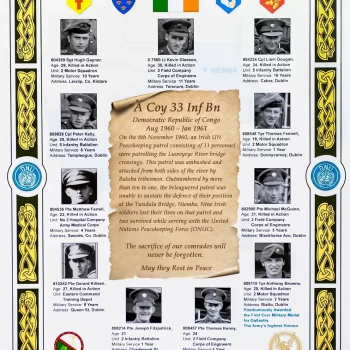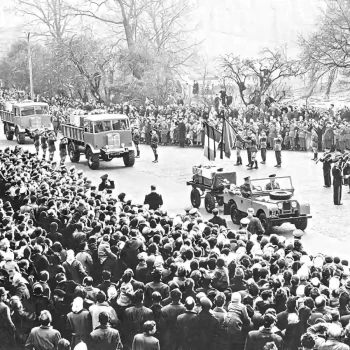By PRO IUNVA
In this article we remember the day 62 years ago when the DF suffered the highest death toll at a crossing point on the Luweyeye River in the Congo.
On Tuesday, 8 Nov 1960, an eleven-man patrol from 2 Pl, A Coy, 33 Inf Bn was attacked by a large number of Baluba tribesmen at a crossing point on the Luweyeye River approximately 20 Km from the platoon base at Niemba village. Nine of the patrol died, eight at the ambush site, and another member of the patrol was subsequently killed a few days later near the village of Tundula, 5 Km from the ambush.
Those who were killed on 8 Nov were:
Lt Kevin M Gleeson (30), 2 Fd Engr Coy from Wainsfort Pk, Terenure
Sgt Hugh F Gaynor (29), 2 Mot Sqn from Newtown, Leixlip
Cpl Liam Dougan (24), 5 Inf Bn from Cuala Rd, Cabra
Cpl Peter J Kelly (25), 5 Inf Bn from Pearse Brothers Pk, Ballyboden
Pte Matthew Farrell (22), 2 Hosp Coy from Jamestown, Swords
Tpr Thomas A Fennell (18), 2 Mot Sqn from Clanranald Rd, Donnycarney
Pte Gerard Killeen (27), CTD (E) from Mountpleasant Buildings, Rathmines
Pte Michael McGuinn (21), 2 Fd Engr Coy originally from Staplestown Rd, Carlow.
Tpr Anthony Browne (20) MMG 2 Mot Sqn from Fatima Mansions, Rialto is believed to have been killed a day or two after 8 Nov. His remains were recovered two years later on 7 Nov 1962.
On 9 Nov, the day after the ambush, the bodies of Lt Gleeson, Sgt Gaynor, Cpl Dougan, Cpl Kelly and Pte McGuinn were recovered by a mixed patrol of Irish and Ethiopian personnel from the ambush site. On the following day three more bodies were found and recovered, they were the bodies of Tpr Fennell, Pte Farrell and Pte Killeen.
Two members of the patrol, Pte Joseph Fitzpatrick (21) from North King St, Dublin and Pte Thomas Kenny (24) from Ballinteer Cottages, Dundrum survived the ambush.
At approximately 2100 hours on 10 Nov, a rooftop sentry in Niemba observed movement about 45 meters from his post and he opened fire. Several other sentries opened fire and cables to a generator were cut and the lighting was extinguished. Pte Patrick H Davis, 2 Fd Engr Coy from Ramillies Rd, Ballyfermot was a sentry on a veranda and he was hit in the stomach from a burst of fire from a Gustaf SMG fired by a fellow soldier. He was treated at the scene but he died as he was being transported by road to Albertville.
On 18 Nov, requiem mass was celebrated at 0500 hours local time at Albertville Airport, military honours were rendered before an aircraft took off at 0645 hours with the bodies of the eight men who were recovered from the ambush site and Pte Davis. The DC4 charter aircraft flew to the Aerodrome at Baldonnel via Entebbe in Uganda, Benghazi in Libya and Marseilles in France. It arrived in Baldonnel at 1700 hours on 19 Nov and the nine coffins were taken to a temporary mortuary in Number 3 Hangar where prayers were said by Right Rev J F O’Regan, Chancellor of the Diocese.
The bodies were escorted from the Congo to Dublin by Capt Donald Crowley (2 IC A Coy), Cpl Michael Colton (DOD Coy) [President of Post 1], Cpl P Anderson (7 Inf Bn), Pte James Kennedy (2 Inf Bn), Tpr Patrick Feeney (2 Mot Sqn) and Pte Peter Donnelly (2 Fd Engr Coy).
On 22 Nov, Requiem Mass was celebrated in the Pro-Cathedral where Arch Bishop John Charles McQuaid presided. After mass the mourners travelled to Baldonnl for the funeral. The cortege consisted of the coffin of Lt Gleeson on a carriage towed by a Landrover followed by four Matador trucks, each carrying two coffins and they were followed by four Landrovers towing trailers with wreaths. A motorcycle escort of honour from 2 Mot Sqn under the command of Lt Kevin P Knightley headed the funeral procession through the city as far as Capel St Bridge where they left and rejoined the cortege at Parnell Sq.
The Chief mourners were:
For Lt Gleeson, his widow Imelda and their daughter Celine, his parents Michael and Agnes Gleeson, his brothers Desmond, Kenneth and Fergus, his sisters Mrs Rosaleen Thomas, Mrs Pauline Harriot, Mrs Muriel Boylan, Geraldine, Ursula, Frances and Marie.
For Sgt Gaynor, his widow Betty, daughters Elizabeth and Sara, sons Brian and Maurice, his sisters Mrs M McKeown, Mrs P Duignan and Mrs Ring.
For Cpl Dougan, his mother Mrs Susan Dougan, his brothers Capt P Dougan, Charles and Michael.
For Cpl Kelly, his widow Elizabeth, daughters Elizabeth and Caroline, his parents Mr & Mrs P Kelly, brothers James, Noel, Patrick and Sean, sisters Constance, Anne, Alice, Elizabeth and Teresa.
For Pte Farrell, his mother Mrs Mary Farrell, his brothers Colm, Edward, Patrick, Christopher, Henry, Michael, Joseph, Thomas and John, his sisters Miss B Farrell, Mrs J Kilbride and Mrs Jervis.
For Tpr Fennell, his parents Mr & Mrs Thomas Fennell, his brothers Niall, John, Peter, Martin, Conal and Liam, his sisters Susan, Pauline, Christine, Mary and Kathleen.
For Pte Killeen, his widow Catherine, his son Gerard, his mother Mrs M Killeen, his brothers Patrick, Sean and Pte T Killeen, his sisters Miss B Killeen and Mrs C Hearty.
For Pte McGuinn, his widow Bridget, his parents Mr & Mrs M McGuinn, his brothers Joseph, John, Patrick, Tomas and Noel, his sisters Kathleen, Mary and Anne.
For Tpr Browne (whose body had not been recovered), his parents Mr & Mrs John Browne, his brothers John and S, his sisters Angela, Marie and Monica.
For Pte Davis, his parents Mr & Mrs James Davis, his brother James, sisters Joan, Peggy, Frances and Georgina.
They were buried in the Army Plot in Glasnevin Cemetery. According to media reports, over a half a million people lined the streets of Dublin for the funeral.
Tpr Anthony Browne survived the initial attack but was subsequently killed. He was posthumously awarded An Bonn Míleata Calmachta (the Military Medal for Gallantry with Distinction), the highest DF award.
Trooper Browne’s citation reads:
“He endeavored to create an opportunity to allow an injured comrade to escape by firing his Gustaf, thereby drawing attention to his own position, which he must have been aware would endanger his life. He had a reasonable opportunity to escape because he was not wounded but chose to remain with an injured comrade.”
Ar dheis Dé go raibh a n-anamacha uaisle.



